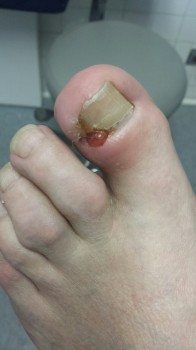Frequently Asked Questions
What vitamins are good for my hair?
I have been asked numerous times in the past few weeks about what vitamins a patient can take to help their nails. There is no simple answer to that question in that numerous vitamins work to promote the health of the nail. The following vitamins help promote the health of the nail–vitamins A, C,E,B and biotin. When looking for a vitamin that helps promote nail health, the vitamin should contain all of these in the proper USDA recommended amounts. Of course, nails can be unhealthy for a variety of reasons. The foot doctor can access if it an infection of the nail or if the patient should be seen by their physician. Patients with systemic disease should be assessed by their physicians and possibly a nutritionist.
Why do I need to see a foot doctor if I broke my toe?

The foot doctor must evaluate the foot and determine what the best course of action is for the situation. The bone beneath the nail may be broken. Also the foot doctor may need to drain the blood beneath the nail to prevent further damage to the nail matrix (factory where the nail is made). Sometimes people drop things on their foot and forget that they did, and then present to the foot doctor with what they believe to be a fungal infection of the nail. The foot doctor puts together symptoms the patient has along with findings to plot the appropriate treatment.
My elderly parent has experience walking problems and has fallen. Can the Foot Doctor determine the cause and how to fix the problem?
Yes the foot Doctor can talk about fall prevention. The Foot Doctor can look at the patient ‘s shoes and advise them if they need replacing. The Foot Doctor can look at the patient’s walking and advise them if they need some type of device to help with their walking. Also the Foot Doctor can discuss and advise the patient about the flooring in their home. With just one visit to the Foot Doctor could mean a world of difference. Remember, a patient can be seriously injured by a fall.
The question commonly asked when visiting my office is why do the patient need orthoses or insoles?
Orthoses are insoles that are custom made for your feet. The devices are appropriate for your foot and the condition it is treating. The insoles are similar to eyeglasses in that they must be used to help you walk better and decrease the stress on your foot. Some devices are for heel spurs and/or plantar fascists. Some other devices are given to children in order to slow down the progression of various juvenile foot conditions. The insoles for children usually help lift the arch up and cup the foot so that it may function in a more efficient bio-mechanical matter. Some insoles are used to treat forefoot pain and may have special padding. There are many types of insoles available to patients that are prefabricated, but this may cause more harm than good. Insoles should be made from impressions of the patient’s foot and other various data that the Foot Doctor gathers.
Why is it important to wear proper foot gear?
The importance of shoe gear cannot be stressed enough in today’s society. Often people purchase shoes based on looks and not function. This is a wrong choice for people with various jobs. The shoe must always be the right size and width. Often people simply walk in and buy the size they always get. This is incorrect because as we age, the width of our feet usually increases for a variety of reasons. People should be measured for their correct shoe size and width. A proper shoe may not be stylish but should have a rigid heel counter in the back of the shoe by the heel. This controls the motion of the foot when we take a step. The front of the shoe should be well padded to absorb the shock of taking the next step forward. The shoe should be rounded or squared toe in order for the toes to have room to function properly. Laces are always preferred because the foot can be locked in and mishaps can be avoided.
